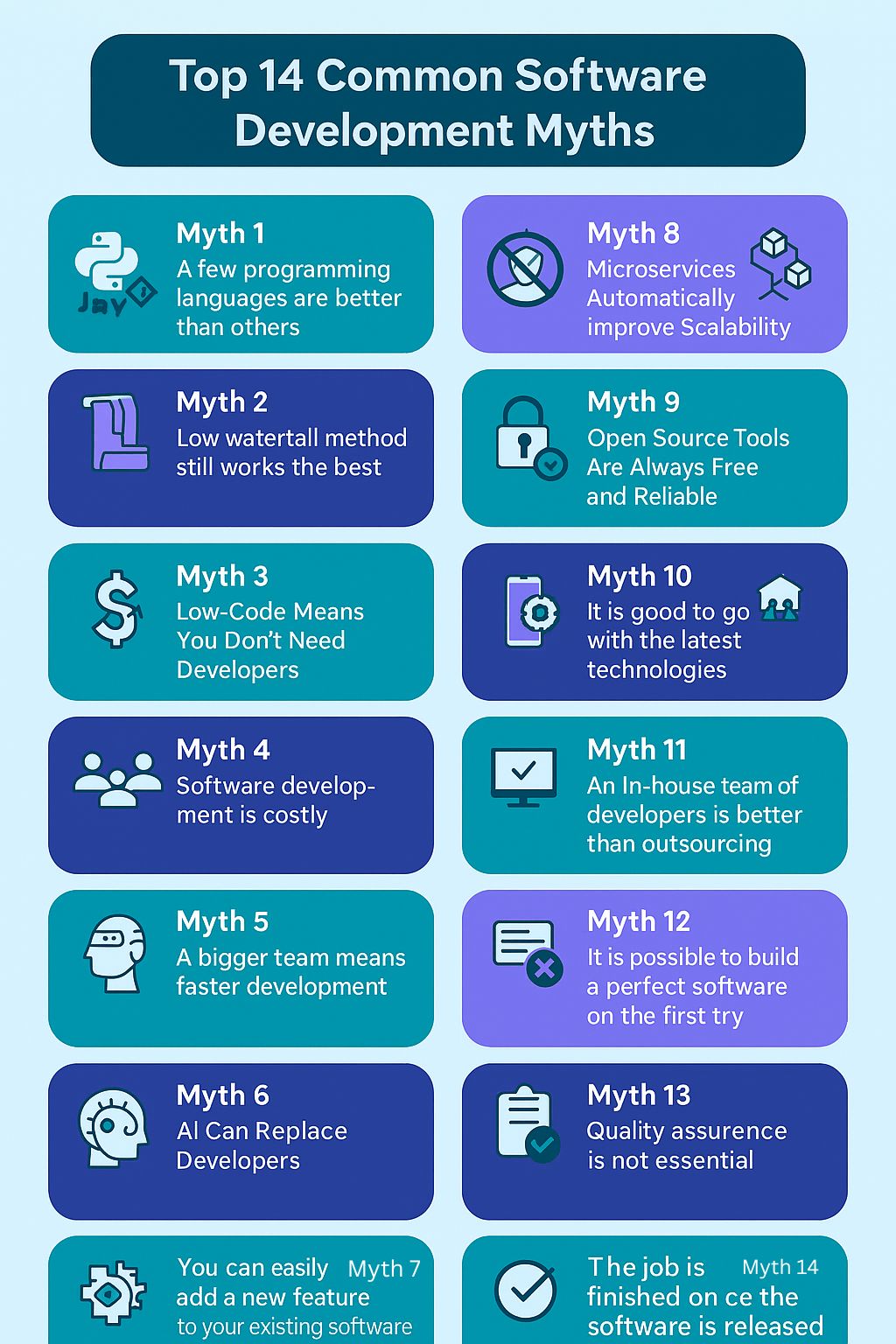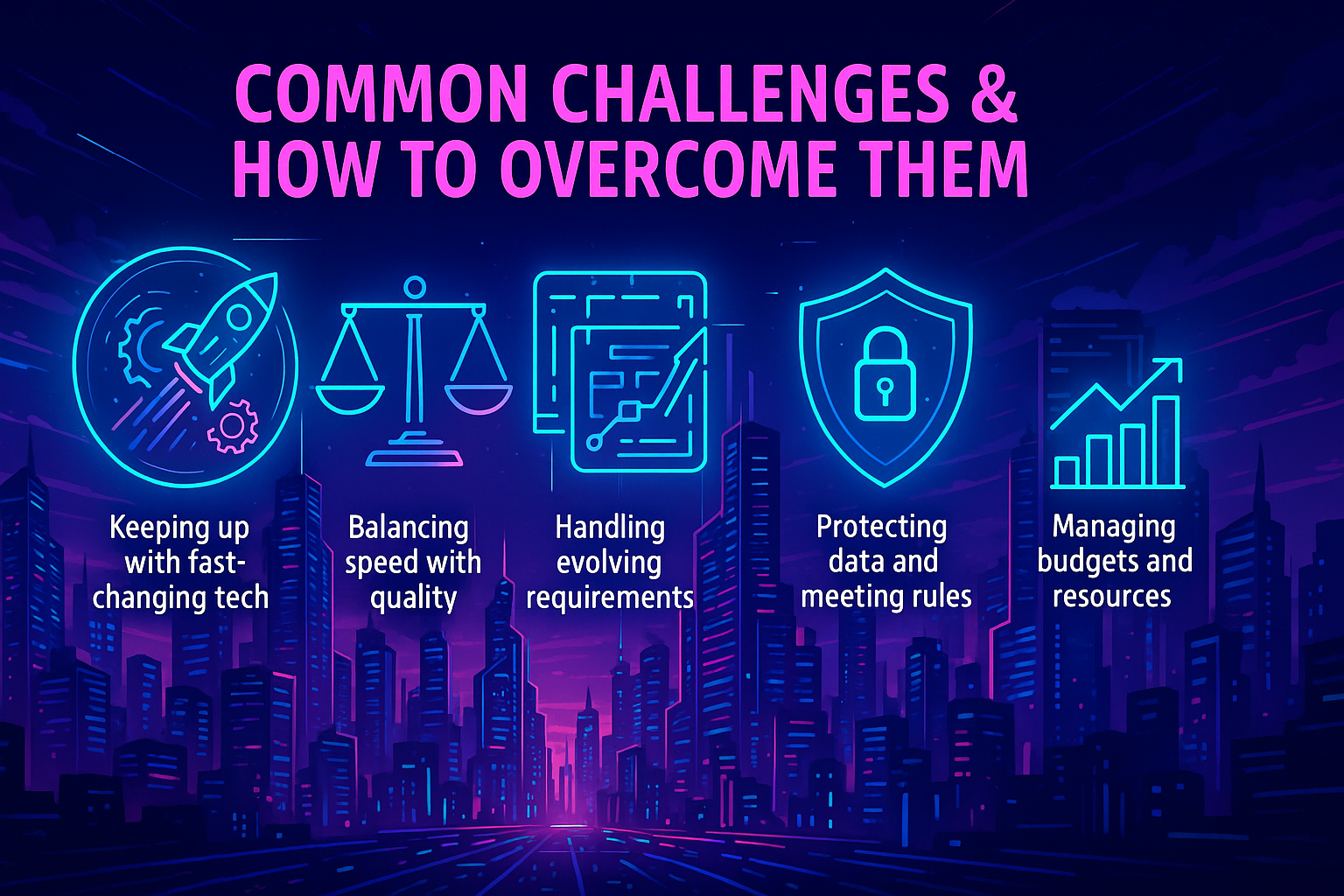
There are many misconceptions and false beliefs in the realm of software development. People that desire to use software development in their company are held back by myths and false beliefs. Making software may save a firm a lot of time and money.
If you, as a company, are choosing not to build software due to these fallacies, you are missing out on an opportunity for your firm to expand to unprecedented heights. We will attempt to clear up some misconceptions about software development in this blog. There are many fallacies surrounding software development, but the top software development companies can help you learn more about the different parts of the process and make an educated choice.
According to Statista, global spending on enterprise software surpassed $1 trillion in 2024, and the application development software market alone is projected to reach $195.77 billion in 2025. Most organizations encounter difficulties due to these misconceptions. Success is defined by the firms that embrace expansion through software development. To help you make an educated choice about how to expand your company, here are the most common fallacies about software development.
In this article, we’ll explore the top software development myths of 2025, debunk coding myths, uncover the truth about AI in programming, highlight outsourcing software risks, and address agile dev misconceptions all with real-world examples and practical advice.
Table of Contents
- Top 14 Common Software Development Myths
- Myth 1: A few programming languages are better than others
- Myth 2: The waterfall method still works the best
- Myth 3: Low-Code Means You Don’t Need Developers
- Myth 4: Software development is costly
- Myth 5: A bigger team means faster development
- Myth 6: AI Can Replace Developers
- Myth 7: You can easily add a new feature to your existing software
- Myth 8: Microservices Automatically Improve Scalability
- Myth 9: Open-Source Tools Are Always Free and Reliable
- Myth 10: It is good to go with the latest technologies
- Myth 11: An in-house team of developers is better than outsourcing
- Myth 12: It is possible to build a perfect software on the first try
- Myth 13: Quality assurance is not essential
- Myth 14: The job is finished once the software is released
- Common Challenges & How to Overcome Them
- Software Development Myth Buster!
- Conclusion
Top 14 Common Software Development Myths
There are many common myths in software development that can mislead businesses and developers alike. Some believe that adding more developers will speed up a project or that software is complete once launched, but these notions are far from the AI coding truth.
In reality, AI tools enhance productivity but don’t replace skilled developers. Another misconception is that in-house teams always outperform external partners, yet outsourcing software risks can be minimized with excellent coordination, often resulting in high-quality outcomes. Dispelling these myths is essential for successful software delivery.
Myth 1: A few programming languages are better than others
Some programming languages are more popular among software developers than others. So, as a businessperson, you could frequently hear engineers say that one programming language is far superior to another. It’s like choosing between French and Italian cuisine. Some individuals will say that French cuisine is the best, while others will say that Italian food is the best.
We all agree that there are certain things that make one programming language superior to another in one way. But if you look at the larger picture, you’ll see that there is no one right way to program. Some programming languages may be better at one thing, while others may be better at another.
You should choose the ideal programming language based on how comfortable the software engineers are with it and what your project needs. By doing so, you can be confident that your software development solutions will consistently meet quality standards.
Myth 2: The waterfall method still works the best
Waterfall is among the well-known software development methodologies. A lot of people who have been around for a long time still think that the waterfall technique is the greatest way to build software.
The waterfall method’s biggest problem is that in the fast-paced world of software development, it’s almost impossible to plan out every little thing before you start creating the system. The truth is that the waterfall technique is not a good way to run a software development project.
A lot of people believe that agile doesn’t need any planning at all. The truth is that any way of making software needs some kind of planning, whether it’s the agile technique or the waterfall method. The manner in which this planning is done is what makes the agile and waterfall methods different.
Waterfall is not particularly flexible or adaptable since it makes you plan out every minute of the software development project from the very beginning.
But agile is a highly flexible methodology since you can tweak and adapt things as the project goes along.
Myth 3: Low-Code Means You Don’t Need Developers
Low-code platforms promise speed, but that doesn’t mean you can eliminate developers. These tools simplify certain tasks, especially for building prototypes or internal tools. However, real-world applications often require customization, integration, security, and scalability—things that still demand skilled developers.
Without a solid software background, it’s easy to hit platform limits. You might struggle with data modeling, workflows, or performance issues. That’s when low-code turns into high-maintenance.
Professional developers know how to work around these limits or extend functionality using traditional code. They ensure systems are secure, efficient, and maintainable. Think of low-code as a helpful shortcut, not a replacement for expertise.
So, while low-code can reduce time-to-market, it’s not a magic wand. You still need developers, just like prefab housing still needs architects and engineers to make it safe and livable.
Myth 4: Software development is costly
You might say that this is the most common fallacy about software development. A lot of businesses give up on developing their own software because they fear it will cost too much.
A lot of people think that software development is expensive, but it may be cheap if you hire the right software development company. These days, there are a number of firms that make software. Over the years, the cost of developing software has gone down since there is more competition.
Moreover, the software development cost can be significantly reduced if you choose to outsource your software development project to a developing nation like India. Don’t make the mistake of not going for software product development just because you think that software development is costly.
In truth, custom software development is not expensive in the long term, and there are many top software development businesses that will construct your program for a reasonable price.
Myth 5: A bigger team means faster development
A frequent fallacy about software development is that if you forget anything during the planning stage, you can always add more developers later to speed up the process.
People often mix up software development with mechanical tasks like making things. In other fields, more is usually better, but not in software development. Most of the time, adding additional personnel to a software project that is already in progress slows things down instead of speeding them up.
This is because you have to teach new individuals about the project and tell them all the facts of the software project when you add them to your team. Instead of introducing new developers to the product, you might have used this time to work on the software product.
Myth 6: AI Can Replace Developers
AI tools are becoming more common in development workflows. According to a recent Global Growth Insights, over 64% of software professionals now use AI tools in some form. That’s a big number and it reflects how fast AI is changing the way teams work. But here’s the truth: AI is a powerful assistant, not a replacement.
While it can suggest code, find bugs, or even write simple functions, it still lacks human thinking. It doesn’t understand your product vision, your user behavior, or your business goals. It can’t hold a conversation about trade-offs or propose a creative solution to a vague problem.
Software development is more than writing lines of codeit’s about solving real-world challenges. Developers think critically, collaborate, and adapt. They take ownership of security, performance, and usabilitythings AI simply can’t do on its own.
Smart teams are embracing AI for what it is: a helpful tool to boost productivity. But behind every great product, there’s still a team of skilled developers driving the ideas forward.
Explore About:- AI in Software Development: Everything to Know
Myth 7: You can easily add a new feature to your existing software
A lot of individuals believe that you may start with fundamental needs and add other ones as you go along. This is not the right approach to think about developing an MVP (Most Viable Product). MVP development has its own set of pros and cons, but you shouldn’t skip over important parts of the software development process just because you believe you can add them later.
You don’t have defined needs in mind before you start constructing the software project, which is why this occurs. In certain circumstances, this will cost you time and money and possibly cause your software project to fail. To speed up the development process and make sure the result is of excellent quality, you need to have good software documentation.
It is hard for the software development team to do adequate testing before they deploy the product if the requirements are constantly changing. This may have an impact on how good the program is. That’s why it’s OK to allow some flexibility for adjustments, but the main elements of the program should be thoroughly thought out.
Myth 8: Microservices Automatically Improve Scalability
Microservices are popular, but they’re not a guaranteed upgrade. The myth is that just switching to microservices will make your system scale better. In reality, microservices add complexity that only pays off when done right.
Breaking a system into small services It works well when you have a mature team, solid DevOps practices, and the need to scale parts of an app independently. But for smaller projects or inexperienced teams, microservices can create more problems than they solve.
Poor communication between services, inconsistent data handling, and deployment headaches are common pitfalls. You need proper orchestration, monitoring, and failover planning, none of which happen by default.
Microservices are a tool, not a shortcut. Startups and mid-sized apps may scale just fine with a well-architected monolith. The right architecture depends on your stage, not the hype.
Myth 9: Open-Source Tools Are Always Free and Reliable
Open source doesn’t mean zero cost or zero risk. Yes, many open-source tools are free to download, but using them in production often comes with hidden costs.
You might need to hire experts to integrate or maintain them. Some tools lack proper documentation or community support. Others are no longer actively maintained, leading to security or compatibility issues. Even licensing can be tricky. some “free” tools have usage restrictions for commercial projects.
Reliability also varies. While some open-source projects (like Linux or Kubernetes) are extremely robust, others are side projects maintained by one developer. Betting your business on the wrong one can be risky.
Open source can be a smart choice, but only if you vet tools carefully and have a plan for long-term support. It’s not “free software.” It’s “free if you know what you’re doing.”
Myth 10: It is good to go with the latest technologies
People often think that the newest software development tools are the finest ones, but that’s not necessarily the case. Instead of picking the newest technology, always choose a tech stack for software development that meets your needs. No matter how great the newest software development tools are, they won’t help your project if they don’t integrate with your tech stack.
Myth 11: An in-house team of developers is better than outsourcing
Keep in mind that putting together and keeping an internal team of developers takes a lot of time and money. You need to interview people, get them settled in, provide them health care and other perks, and so on.
It might also cost more to hire developers in-house. You need to rent office space and provide your in-house developers computers, laptops, and other tools. This is in addition to paying them their salary and perks.
You won’t be sure that your in-house team of developers will make a solid product after all this. You might also hire a top software product development team to produce your software product instead.
In the last several years, Software development outsourcing has been a common practice in the business. Outsourcing software development gives organizations quick access to skilled and experienced software engineers. If you opt to outsource the creation of your software product to a developing country, you may also save money on software development.
If you choose the correct team, hiring remote developers is much better than hiring an in-house development team.
Myth 12: It is possible to build a perfect software on the first try
A lot of individuals think that they can make a fantastic software product on the first attempt, even though it’s a really hard job. This is not true at all. Most software development teams use an iterative method, which means they start with a little concept and test it before going all in.
The MVP, or Minimum Viable Product, is usually the initial version of a bespoke software product, and it’s not flawless. The goal is to figure out what works and what doesn’t before making the whole thing. Software development can’t be done well the first time, and there will be several versions before the final result is delivered.
Myth 13: Quality assurance is not essential
Many business owners believe that QA is a non-essential and time-consuming process, and it can be skipped. The reality is that software testing is an integral part of the software development process. A robust QA process will ensure that the final product is devoid of bugs.
Dedicated software testers are in charge of checking several parts of software, such as how well it works and how easy it is to use. In the long run, spending some money on Software QA testing will save you money and protect your reputation.
Myth 14: The job is finished once the software is released
When a software project is released, it is not done. The fact is, every piece of software has its own life cycle, just as living things do, since the market is always changing. You need to keep your software up-to-date with the changing needs of users and the market. Every software product needs more than just updates to stay up and running. It also needs a good maintenance plan.
Common Challenges & How to Overcome Them
Making applications is fun, but it can also be hard. Teams often have to deal with tight deadlines, shifting requirements, and tight budgets, all of which may slow down development or change the outcomes. Fortunately, these issues can be fixed with the greatest application development tools, clever techniques, and the right technology. There are a lot of fallacies about software development that might make things harder in the actual world. Here’s how to deal with these problems and clear up the misunderstandings. Here are some frequent problems and ways to fix them:
Keeping up with fast-changing tech
New tools and upgrades come out all the time. Keeping up with the latest news and picking platforms that may change helps keep growth on track.
- Myth: You have to have a great strategy before you start.
- Reality and Solution: Technology changes quickly; therefore, you don’t need a perfect strategy to get started. Use platforms that are modular and can be changed and developed in stages. Keep studying and stay up-to-date on new tools and frameworks.
Balancing speed with quality
There is a lot of pressure to get things done quickly, yet doing so might lead to blunders. Automation and low-code alternatives make things go faster without skipping steps.
- Myth: Faster development usually implies worse quality.
- Reality and Solution: You can deliver rapidly without losing quality if you use Agile methodologies and automation. Use low-code technologies and automated testing to keep up with requirements while speeding up delivery.
Handling evolving requirements
The demands of a business might vary throughout a project. It’s simpler to make changes when you talk clearly and split tasks into smaller parts.
- Myth: Once development begins, requirements shouldn’t alter.
- Reality & Solution: Change is unavoidable. Agile and Scrum reduce work down into smaller parts, which makes it simpler to adjust to changing business demands and keep stakeholders informed.
Protecting data and meeting rules
You need to be sure about important rules. Adopting top rapid application development software with high security and following regulations makes data safer.
- Myth: You can make your software more secure after it is built.
- Reality & Solution: Both security and compliance should be prepared at the beginning of the process. Choose methods that make development secure, use platforms that offer strong safety, and stick to regulations for a safer outcome
Managing budgets and resources
Managing both money and team resources is usually quite challenging. Begin with a simple setting and develop it as needed to make sure money isn’t wasted.
- Myth: This myth is not true; hiring new developers will not consistently speed up projects delivered late.
- Reality & Solution: It takes longer for more people to get settled and coordinate actions, which slows things down. Handle things step by step, add on as required, and use management approaches to manage resources.
Addressing these myths gives teams higher chances of solving usual software development problems and completing projects successfully. Facing these problems and choosing suitable tools make it possible for businesses of all sizes to develop good, safe, and new apps to match their needs. In any area of enterprise IT, when planning is good and technology is flexible, challenges can be seen as space for growth and opportunity.
Software Development Myth Buster!
People often believe software development is always pricey, taking shortcuts ensures success, or having a larger team on a late project will finish things faster; these are not true. Taking things at a fast pace often leads to poorly built code, and there are times when extra people are needed to speed up learning and new project contributions. Sometimes, it is believed that requirements will not change, but needs, by nature, change and are easily dealt with when using agile.
Security should be part of the planning process right from the beginning to stop expensive repairs in the future. Maintenance of software is always required, so just deploying it does not complete the process. We hope that this blog has helped clear up some of the most common fallacies about software development. Don’t believe these fallacies, and don’t choose software development; it may be quite helpful for your organization. Asking the professionals is the greatest approach to get the facts about software development. So get in touch with a top software development firm and tell them about your worries and questions. Then ask them how bespoke software may help your business expand.
Conclusion
The greatest application development software is altering how businesses create digital solutions. By 2025, businesses will need them, not just want them. These tools cut down expenses, speed up development, and make it simpler than ever to build tools. A wide range of professionals work together to create software, including business analysts, UX/UI designers, testers, quality assurance specialists, project managers, and product developers. By actively challenging outdated thinking, educating stakeholders, and embracing transparency, you create stronger teams, smoother workflows, and better software outcomes. Busting software development myths 2025 isn’t just a mindset shift; it’s a strategic advantage
These development specialists are all very good at what they do, and each one plays a crucial part in the development process. No matter how big or small the business is, contemporary platforms provide great advantages, including low-code alternatives, solid security, and seamless performance. This implies that developers may easily make applications that are tailored to their needs and work well. Ext JS is an excellent example of a platform that helps companies make good apps since it is flexible, fast, and has a supportive community. Companies can move quicker, come up with new ideas, and remain ahead in today’s fast-paced digital environment by using these technologies
FAQs
1. What are the most common myths about software development?
Some widespread myths include: software development is fast and easy, adding features later is simple, good developers don’t need documentation, and testing isn’t necessary if the code works.
2. Is it true that software development only involves coding?
No, software development also includes planning, design, testing, deployment, and maintenance. Coding is just one part of a much larger and strategic development process.
3. Why is the myth “more developers mean faster delivery” incorrect?
Adding more developers to a late or complex project can lead to communication overhead and decreased efficiency — often referred to as Brooks’ law in software engineering.
4. Do agile and scrum guarantee faster software delivery?
Agile helps with flexibility and feedback loops but doesn’t automatically mean faster results. It’s a process that still requires planning, discipline, and effective team collaboration.
5. Is it a myth that once the software is launched, the work is done?
Yes, that’s a myth. Post-launch tasks like bug fixes, feature updates, performance monitoring, and user feedback integration are critical for a successful and sustainable software product.
 Avantika Shergil
| Jun 27, 2025
Avantika Shergil
| Jun 27, 2025
Avantika Shergil is a technology enthusiast and thought leader with deep expertise in software development and web technologies. With over 8 years of experience analyzing and evaluating cutting-edge digital solutions, Avantika has a knack for demystifying complex tech trends. Her insights into modern programming frameworks, system architecture, and web innovation have empowered businesses to make informed decisions in the ever-evolving tech landscape. Avantika is passionate about bridging the gap between technology and business strategy, helping businesses build customized software and website, and understand about different tools to leverage effectively for their ventures. Explore her work for a unique perspective on the future of digital innovation.








